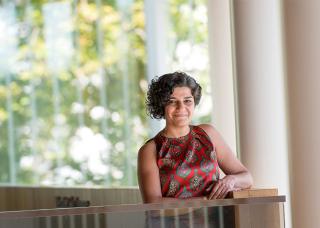Fighting the good fight


When it comes to conflict, most people try to avoid it. But Aftab Erfan, UBC's first Director of Dialogue and Conflict Engagement in the Equity & Inclusion Office, views it as an opportunity for growth and change.
“I define conflict as a difference that matters enough to mobilize our emotional resources,” she explains. “As our community becomes more diverse and we increasingly recognize our differences, you might actually expect conflict to become more prevalent—and the creation of my position at UBC is an acknowledgment that this is not a problem. In fact, if we can engage with it, conflict can be kind of a doorway to learning and transformation.”
Aftab brings a unique perspective to her role; raised in Iran, she came to Canada at the age of 14 and, as a UBC undergraduate, she pursued studies in fine arts and environmental sciences. She followed that up with a masters in urban planning from McGill University, and worked as a planner in Halifax and North Vancouver. It was during this work that Aftab felt drawn to conflict resolution.
“A lot of my planning work involved negotiating between people and trying to make collective decisions about things that people fundamentally disagree about,” she explains. She decided to explore this further in a PhD at the UBC School of Community and Regional Planning (SCARP), going to South Africa to learn from Myrna Lewis, a practitioner who pioneered a facilitation and conflict-resolution method called Deep Democracy. Aftab earned her PhD in 2013 and began teaching with SCARP, in addition to working as a professional facilitator both locally and internationally. In March 2017, she was recruited for the role with the Equity & Inclusion Office.
If we can engage with it, conflict can be kind of a doorway to learning and transformation.
Aftab Erfan
Aftab’s role is split between creating a strategic vision for conflict engagement on the Vancouver and Okanagan campuses, offering workshops to build the capacity of UBC staff, faculty and students for having difficult conversations, and facilitating dialogues to address areas of tension within various university units or on campus.
“The request to do an intervention in a unit usually comes from the leadership of the unit,” she explains. “Once we can pinpoint the contentious conversation that needs to be had, I can come in and facilitate that. Sometimes I do a lot of groundwork to help the group develop readiness for the conversation and to get the framing and process right. Conflict can be difficult for people. We can make it easier by structuring the process and offering a third party who has everyone’s best interest in mind.”
A recent public event she co-facilitated was a 'Chat and Chai' discussion organized by the Muslim Students Association about humour. “The topic came to my attention because there were a number of places on campus where student events that were supposed to be funny had offended people,” Aftab explains. “Of course, on the surface of it, this is a conflict about bad jokes, but it’s related to everything the Equity & Inclusion Office is trying to work on. Using a topic like humour to talk about racism and sexism is, in some ways, more productive than trying to talk about racism and sexism directly.”
At its core, says Aftab, conflict engagement is about supporting diversity, which includes transforming our structures to do so. “Diversity is a crucial ingredient for deep learning, innovation and excellence. But you can’t just put a diverse group of people together and expect them to get along and reap all the benefits,” she insists. “You have to create the right conditions for those benefits to come about. Working with conflict is one way of creating those conditions. It’s a way of making diversity really practical and valuable.”
About the Equity & Inclusion Office
Find the latest news, updates, events, and useful dates from across UBC, curated for faculty and staff by Internal Communications.
Access a library of resources from multiple UBC websites, all in one place.